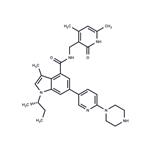GSK126 is an effective EZH2 methyltransferase inhibitor with IC50 being 9.9nM and high selectivity on EZH2 which is over 1000 times higher than that of the other twenty human methyltransferases.
GSK126 induced a 50% loss of H3K27 tri-methylation (H3K27me3) in both EZH2 wild-type and mutant DLBCL cell lines at concentrations ranging from 7–252 nM independent of EZH2 mutation status. GSK126 suppresses cell proliferation of a panel of B-cell lymphoma cell lines. Six of the seven most sensitive DLBCL cell lines harboured Y641N, Y641F or A677G EZH2 mutations (growth IC50 = 28–861 nM). 72 h treatment with 500 nM GSK126 induces transcriptional activation in sensitive cell lines.
GSK126 treated once-daily for 10 days decreases global H3K27me3 and increases gene expression in subcutaneous xenografts of KARPAS-422 in a dose-dependent fashion. With daily 50 mg per kg dosing, complete tumour growth inhibition is observed. When higher dosing regimens are examined with KARPAS-422 xenografts, marked tumour regression is observed. Upon cessation of dosing, tumours in the 50 mg per kg once daily group shows tumour stasis whereas complete tumour eradication is observed in the 150 mg per kg once daily and 300 mg per kg twice per week groups. Tumour growth inhibition also correlates with statistically significant increased survival of mice bearing the more aggressive KARPAS-422 tumours, where spontaneous deaths occurres in vehicle-treated animals. No significant changes in any blood cell types at doses and times where efficacy is observed in tumour xenografts.
The histone H3 lysine 27 (H3K27) methyltransferase EZH2 plays an important role in regulating gene expression, and its aberrant activity is linked to the onset and progression of cancer. GSK126 is a selective, S-adenosyl-methionine-competitive small molecule inhibitor of EZH2 methyltransferase activity (Ki = 0.57 nM; IC50 = 9.9 nM versus that of EZH1: Ki = 89 nM; IC50 = 680 nM). It is more than 1,000-fold selective for EZH2 over other histone methyltranferases, including both SET-domain-containing and non-SET-domain-containing methyltransferases. At concentrations of 7-252 nM, it has been shown to inhibit global H3K27 trimethylation levels and to reactivate silenced PRC2 target genes. Furthermore, GSK126 can inhibit the proliferation of EZH2 mutant DLBCL cell lines (IC50 = 28-61 nM) as well as the growth of EZH2 mutant DLBCL xenografts in mice receiving a daily dose of 50 mg/kg.
GSK126 is a potent and highly selective S-adenosyl-methionine-competitive small molecule inhibitor of EZH2 methyltransferase enzyme activity. The inhibition activity of GSK126 on EZH2 activity may provide a promising treatment for EZH2 mutant lymphoma.
ChEBI: 1-[(2S)-butan-2-yl]-N-[(4,6-dimethyl-2-oxo-1H-pyridin-3-yl)methyl]-3-methyl-6-[6-(1-piperazinyl)-3-pyridinyl]-4-indolecarboxamide is a member of piperazines and a member of pyridines.
1. sato, t., et al., prc2 overexpression and prc2-target gene repression relating to poorer prognosis in small cell lung cancer. sci rep, 2013. 3(1911). 2. mccabe, m.t., et al., ezh2 inhibition as a therapeutic strategy for lymphoma with ezh2-activating mutations. nature, 2012. 492(7427): p. 108-12. 3. van aller, g.s., et al., long residence time inhibition of ezh2 in activated polycomb repressive complex 2. acs chem biol, 2014. 9(3): p. 622-9. 4. yeh, c.m., et al., epigenetic silencing of arntl, a circadian gene and potential tumor suppressor in ovarian cancer. int j oncol, 2014. 45(5): p. 2101-7.


